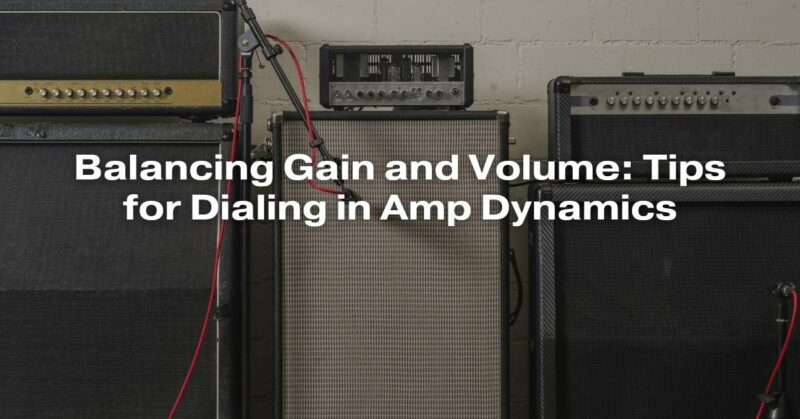When it comes to achieving the perfect guitar tone, one of the most critical aspects to consider is finding the right balance between gain and volume in your amplifier. Whether you’re a seasoned guitarist or just starting, understanding how to manipulate these two parameters is essential for achieving the tone you desire. In this comprehensive article, we’ll delve into the art of balancing gain and volume to help you master the dynamics of your amplifier.
Understanding Gain and Volume
Before we dive into the tips and techniques for balancing gain and volume, it’s crucial to understand the fundamental difference between the two:
1. Gain: Gain refers to the amount of overdrive or distortion in your signal. It’s what gives your guitar tone its crunch, sustain, and character. Increasing the gain adds grit and saturation to your sound, while reducing it results in a cleaner, less distorted tone. Gain is usually controlled by a knob on your amplifier, pedal, or modeling unit.
2. Volume: Volume, on the other hand, controls the overall loudness of your signal. It determines how loud your guitar is in the mix and how it interacts with other instruments. It can be adjusted on your amplifier, pedal, or even directly on your guitar.
Balancing Act: Why It Matters
Balancing gain and volume effectively is essential for several reasons:
1. Tone Shaping: The right balance between gain and volume can shape your tone significantly. Too much gain can make your sound mushy and indistinct, while too little can result in a lack of sustain and presence.
2. Clarity: Finding the right balance ensures that your guitar cuts through the mix while maintaining clarity and definition, which is crucial, especially in a band context.
3. Dynamics: Properly balancing gain and volume allows you to maintain dynamic control over your playing. You can go from clean to crunch to high-gain with ease, enhancing your expressiveness as a guitarist.
4. Amp Health: Running your amplifier at the appropriate gain and volume levels can extend the life of your equipment. Pushing an amp too hard can lead to overheating and damage.
Tips for Balancing Gain and Volume
Now that we understand the significance of this balance, let’s explore some practical tips to help you achieve the perfect amp dynamics:
1. Start with a Clean Slate: Begin by setting both your gain and volume controls to their lowest settings. This ensures a clean, neutral starting point.
2. Set Your Guitar’s Volume: Before touching the amp controls, adjust your guitar’s volume knob. Lowering it can clean up your sound, while increasing it will drive the amp harder, increasing gain.
3. Gain First, Then Volume: It’s generally a good practice to set your gain first and then adjust the volume. Begin by increasing the gain until you achieve the desired amount of distortion or overdrive for your tone. Be mindful not to overdo it; excessive gain can result in a loss of clarity.
4. Dial in the Volume: After you’ve set your gain, start adjusting the volume to the appropriate level for the situation. In a bedroom practice scenario, you won’t need as much volume as you would on stage. Remember that turning up the volume will naturally increase the intensity of the overdrive.
5. Use Your Ears: Trust your ears throughout the process. Listen carefully and make subtle adjustments to both gain and volume until you find the sweet spot that suits your playing style and the musical context.
6. Consider Your Pick Attack: The way you pick or strum your strings also affects the dynamics. A lighter touch will result in cleaner tones, while aggressive playing will drive the amp harder and introduce more gain and volume naturally.
7. Experiment with Different Guitars and Pickups: Different guitars and pickups can interact with your amp’s gain and volume settings differently. Experiment with various combinations to discover new tones and textures.
8. Use Pedals Wisely: If you use pedals to shape your tone, remember that they can interact with your amp’s gain and volume settings. Experiment with pedal placement and settings to fine-tune your sound.
9. Know Your Amp: Every amplifier is unique. Get to know the specifics of your amp and how it responds to changes in gain and volume. Some amps are more forgiving at high gain settings, while others may become too compressed or noisy.
10. Record and Listen: Recording your guitar playing and listening back can be extremely enlightening. It allows you to hear your tone objectively and make adjustments accordingly.
Conclusion
Balancing gain and volume is a fundamental skill for any guitarist looking to sculpt their perfect tone. It’s a dynamic process that depends on your playing style, musical context, and equipment. By following these tips and experimenting with different settings, you’ll develop a keen ear for finding the right balance between gain and volume, allowing you to unlock a world of tonal possibilities and dynamic expressiveness in your playing. Remember that the quest for the perfect tone is a journey, and there are no one-size-fits-all answers. Enjoy the process of discovery and let your ears guide you to your signature sound.


